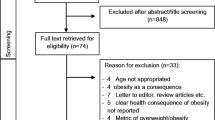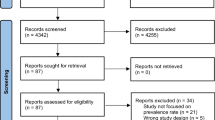Abstract
The objective of this study was to assess the prevalence of modifiable risk factors of the major non-communicable diseases (NCDs) among medical students. A cross sectional study was conducted at three randomly selected medical colleges in the Kathmandu Valley in Nepal. All third-year medical students (n = 191) participated in the study. A total of 62.3 % of the respondents were male, and 37.7 % were female. The mean age of the respondents was 21.5 ± 1.0 (SD) years. A total of 20.4 % (n = 39) of the medical students were current tobacco users and 50.8 % (n = 97) have ever consumed alcohol. The majority (85.6 %) of the medical students did not consume the daily recommended amount of fruits and vegetables. A total of 30.9 % (n = 59) of the medical students were involved in low level of physical activity and 42.9 % (n = 82) were involved in moderate level of physical activity. This study showed a high prevalence of risk factors of major NCDs among medical students and interventions are needed to change the unhealthy behaviour of medical students being role models in society.
Similar content being viewed by others
References
World Health Organization. (2011). Global status report on noncommunicable diseases. Geneva: WHO.
WHO South-East Asia Region. (2011). Noncommunicable diseases in the South-East Asia Region. India: WHO SEARO.
World Health Organization. (2002). Health situation in the South-East Asia region 1998–2000. SEA/HS/222. New Delhi: WHO Regional Office for South-East Asia.
Neupane, D., & Kallestrup, P. (2013). Non-communicable diseases in Nepal: Challenges and opportunities. Journal of Nepal Health Research Council, 11(24), 225–228.
Bhandari, G. P., Angdembe, M. R., Dhimal, M., Neupane, S., & Bhusal, C. (2014). State of non-communicable diseases in Nepal. BMC public health, 14(1), 23.
Lopez, A. D., Mathers, C. D., Ezzati, M., Jamison, D. T., Murray, C., Haisma, H., et al. (2006). Global burden of disease and risk factors (pp. 2945–2951). Washington, DC: World Bank.
Mokdad, A. H., Marks, J. S., Stroup, D. F., & Gerberding, J. L. (2004). Actual causes of death in the United States, 2000. JAMA, the Journal of the American Medical Association, 291(10), 1238–1245.
Li, Y., Wang, L., Jiang, Y., Zhang, M., & Wang, L. (2013). Risk factors for noncommunicable chronic diseases in women in China: surveillance efforts. Bulletin of the World Health Organization, 91(9), 650–660.
World Health Organization. (2008). 2008–2013 action plan for the global strategy for the prevention and control of noncommunicable diseases: Prevent and control cardiovascular diseases, cancers, chronic respiratory diseases and diabetes. Geneva: World Health Organization.
Talwar, K., Grover, A., & Thakur, J. (2011). Role of medical education in preventing and control of noncommunicable diseases in India? Indian Journal of Community Medicine : Official Publication of Indian Association of Preventive and Social Medicine, 36(Suppl 1), S63–S66.
Naidana, P. S., & Addanki, S. P. K. (2013). A comparative study on lifestyle pertaining to risk of chronic non-communicable diseases between the students of two professional colleges. International Journal of Medical and Health Sciences, 2(1), 36–41.
Shakya, A., Mishra, S. R., Giri, S., Paudel, K. & Neupane, D. (2015). Gender differences and clustering of modifiable risk factors of non-communicable diseases among medical students: A cross sectional study in Nepal. Journal of Community Health, 40, 147–152.
Slusser, M. S., & Slusser, M. (1982). Nepal mandala: A cultural study of the Kathmandu Valley. Princeton: Princeton University Press.
Central Bureau of Statistics. (2011). National population and housing census 2011. Kathmandu: CBS.
Medical Colleges in Nepal. (2013). List of medical colleges in Nepal [cited 2014]. http://www.medicalcollegesnepal.com/category/list-of-colleges/page/3/.
World Health Organization. (2008). WHO steps instrument question-by-question guide (core and expanded). Geneva: World Health Organization.
Ministry of Health and Population (DoHS), Society for Local Integrated Development Nepal (SOLID Nepal), & WHO. (2008). Nepal non-communicable disease risk factor survey. Kathmandu: MoHP, SOLID Nepal and WHO.
Medline Plus. (2013). Alcoholism and alcohol abuse [cited 2014]. http://www.nlm.nih.gov/medlineplus/ency/article/000944.htm.
Oli, N., Vaidya, A., & Thapa, G. (2013) Behavioural risk factors of noncommunicable diseases among Nepalese Urban poor: A descriptive study from a Slum Area of Kathmandu. Epidemiology Research International, 2013
Budhathoki, N., Shrestha, M. K., Acharya, N., & Manandhar, A. (2010). Substance use among third year medical students of Nepal. Journal of Nepal Health Research Council, 8(1), 15–18.
Khanal, P., Ghimire, R. H., Gautam, B., Dhungana, S. K., Parajuli, P., Jaiswal, A. K., et al. (2010). Substance use among medical students in Kathmandu valley. JNMA: Journal of the Nepal Medical Association, 50(180), 267–272.
Shyangwa, P. M., Joshi, D., & Lal, R. (2007). Alcohols and other substance use/abuse among junior doctors and medical students in a teaching institute. JNMA: Journal of the Nepal Medical Association, 46(167), 126–129.
Kumar, S., Pokharel, B., Nagesh, S., & Yadav, B. K. (2006). Alcohol use among physicians in a medical school in Nepal. Kathmandu University Medical Journal (KUMJ), 4(4), 460–464.
Giri, S., Sharma, S. R., Timalsina, S., Yadav, V., Koirala, S., Kumar, A., et al. (2012). Cardiovascular health risk behavior among medical students in a teaching hospital. Journal of Nepal Health Research Council, 10(22), 187–191.
Croen, L. G., Woesner, M., Herman, M., & Reichgott, M. (1997). A longitudinal study of substance use and abuse in a single class of medical students. Academic Medicine : Journal of the Association of American Medical Colleges, 72(5), 376–381.
Bertsias, G., Linardakis, M., Mammas, I., & Kafatos, A. (2005). Fruit and vegetables consumption in relation to health and diet of medical students in Crete, Greece. International Journal for Vitamin and Nutrition Research Internationale Zeitschrift fur Vitamin- und Ernahrungsforschung Journal international de vitaminologie et de nutrition, 75(2), 107–117.
Spencer, E. H., Frank, E., Elon, L. K., Hertzberg, V. S., Serdula, M. K., & Galuska, D. A. (2006). Predictors of nutrition counseling behaviors and attitudes in US medical students. The American Journal of Clinical Nutrition, 84(3), 655–662.
Sakamaki, R., Toyama, K., Amamoto, R., Liu, C.-J., & Shinfuku, N. (2005). Nutritional knowledge, food habits and health attitude of Chinese university students—A cross sectional study. Nutrition Journal, 4(1), 4.
Anand, T., Tanwar, S., Kumar, R., Meena, G. S., & Ingle, G. K. (2011). Knowledge, attitude, and level of physical activity among medical undergraduate students in Delhi. Indian Journal of Medical Sciences, 65(4), 133–142.
El-Gilany, A.-H., & El-Masry, R. (2011). Physical inactivity among Egyptian and Saudi Medical Students. TAF Preventive Medicine Bulletin, 10(1), 35–44.
Ranasinghe, C. D., Ranasinghe, P., Jayawardena, R., & Misra, A. (2013). Physical activity patterns among South-Asian adults: A systematic review. The International Journal of Behavioral Nutrition and Physical Activity, 10, 116.
Rao, C. R., Darshan, B., Das, N., Rajan, V., Bhogun, M., & Gupta, A. (2012). Practice of physical activity among future doctors: A cross sectional analysis. International Journal of Preventive Medicine, 3(5), 365–369.
Gnanendran, A., Pyne, D. B., Fallon, K. E., & Fricker, P. A. (2011). Attitudes of medical students, clinicians and sports scientists towards exercise counselling. Journal of Sports Science and Medicine, 10(3), 426.
Dabrowska-Galas, M., Plinta, R., Dabrowska, J., & Skrzypulec-Plinta, V. (2013). Physical activity in students of the Medical University of Silesia in Poland. Physical Therapy, 93(3), 384–392.
Pandey, S. (2014). Getting active-challenges in a developing country UK: Exercise works [cited 2014]. http://www.exercise-works.org/latest-news/2014/3/5/getting-active-challenges-in-a-developing-country.html.
Van der Veer, T., Frings-Dresen, M. H., & Sluiter, J. K. (2011). Health behaviors, care needs and attitudes towards self-prescription: A cross-sectional survey among Dutch medical students. PLoS One, 6(11), e28038.
Acknowledgments
The authors would like to thank all the students and medical colleges that participated in the study. This research received no specific grant from any funding agency in the public, commercial or not-for-profit sectors.
Conflict of interest
None.
Author information
Authors and Affiliations
Corresponding author
Rights and permissions
About this article
Cite this article
Mishra, S.R., Neupane, D., Shakya, A. et al. Modifiable Risk Factors for Major Non-communicable Diseases Among Medical Students in Nepal. J Community Health 40, 863–868 (2015). https://doi.org/10.1007/s10900-015-0012-6
Published:
Issue Date:
DOI: https://doi.org/10.1007/s10900-015-0012-6




